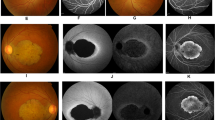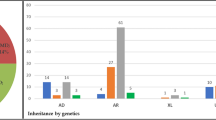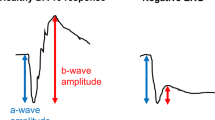Abstract
Total colourblindness (OMIM 216900), also referred to as rod monochromacy (RM) or complete achromatopsia, is a rare, autosomal recessive inherited and congenital disorder characterized by photophobia, reduced visual acuity, nystagmus and the complete inability to discriminate between colours1. Electroretinographic recordings show that in RM, rod photoreceptor function is normal, whereas cone photoreceptor responses are absent. The locus for RM has been mapped to chromosome 2q11 (ref. 2), however the gene underlying RM has not yet been identified. Recently, a suitable candidate gene, CNGA3, encoding the α-subunit of the cone photoreceptor cGMP-gated cation channel, a key component of the phototransduction pathway, has been cloned and assigned to human chromosome 2q11 (Refs 3,4). We report the identification of missense mutations in CNGA3 in five families with RM. Homozygous mutations are present in two families, whereas the remaining families show compound heterozygous mutations. In all cases, the segregation pattern of the mutations is consistent with the autosomal recessive inheritance of the disease and all mutations affect amino acids that are highly conserved among cyclic nucleotide gated channels (CNG) in various species. This is the first report of a colour vision disorder caused by defects other than mutations in the cone pigment genes, and implies at least in this instance a common genetic basis for phototransduction in the three different cone photoreceptors of the human retina.
This is a preview of subscription content, access via your institution
Access options
Subscribe to this journal
Receive 12 print issues and online access
$209.00 per year
only $17.42 per issue
Buy this article
- Purchase on Springer Link
- Instant access to full article PDF
Prices may be subject to local taxes which are calculated during checkout



Similar content being viewed by others
Accession codes
References
Sharpe, L.T. & Nordby, K. Total colour blindness: An introduction . in Night vision: basic, clinical and applied aspects (eds Hess, R.F., Sharpe, L.T. & Nordby, K., Cambridge University Press, Cambridge, 1990).
Arbour, N. et al. Homozygosity mapping of achromatopsia to chromosome 2 using DNA pooling. Hum. Mol. Genet. 6, 689–694 (1997).
Yu, W.-P., Grunwald, M.E. & Yau, K.-W. Molecular cloning, functional expression and chromosomal localization of a human homolog of the cyclic nucleotide-gated ion channel of retinal cone photoreceptors . FEBS Lett. 393, 211–215 (1996).
Wissinger, B. et al. Cloning, chromosomal localization and functional expression of the gene encoding the α-subunit of the cGMP-gated channel in human cone photoreceptors . Eur. J. Neurosci. 9, 2512– 2521 (1997).
Wissinger, B. et al. Human rod monochromacy: linkage analysis and mapping of a cone photoreceptor expressed candidate gene on chromosome 2q11. Genomics (in press).
Baumann, A., Frings, S., Godde, M., Seifert, R. & Kaupp, U.B. Primary structure and functional expression of a drosophila cyclic nucleotide-gated channel present in eyes and antennae. EMBO J. 13, 5040–5050 ( 1994).
Coburn, C.M. & Bargmann, C.I. A putative cyclic nucleotide-gated channel is required for sensory development and function in C. elegans . Neuron 17, 695–706 (1996).
Weyand, I. et al. Cloning and functional expression of a cyclic-nucleotide-gated channel from mammalian sperm. Nature 368, 859– 863 (1994).
Bönigk, W. et al. Rod and cone photoreceptor cells express distinct genes for cGMP-gated channels . Neuron 10, 865–877 (1993).
Pittler, S.J. et al. Primary structure and chromosomal localization of human and mouse rod photoreceptor cGMP-gated cation channel. J. Biol. Chem. 267, 6257–6262 (1992).
Zagotta, W.N. & Siegelbaum, S.A. Structure and function of the cyclic nucleotide-gated channels. Annu. Rev. Neurosci. 19, 235–263 (1996).
Brown, R.L., Gramling, R., Bert, R.J. & Karpen, J.W. Cyclic GMP contact points within the 63kDa subunit and a 240kDa associated protein of retinal rod cGMP-activated channels. Biochemistry 34, 8365–8370 (1995).
Dryja, T.P. et al. Mutations in the gene encoding the α-subunit of the rod cGMP-gated channel in autosomal recessive retinitis pigmentosa. Proc. Natl Acad. Sci. USA 92, 10177–10181 ( 1995).
Dryja, T.P., Berson, E.L., Rao, V.R. & Oprian, D.D. Heterozygous missense mutation in the rhodopsin gene as a cause of congenital stationary night blindness. Nature Genet. 4, 280– 283 (1993).
Fain, G.L. & Lisman, J.E. Photoreceptor degeneration in vitamin A deprivation and retinitis pigmentosa: the equivalent light hypothesis. Exp. Eye Res. 57, 335–340 (1993).
Payne, A.M. et al. A mutation in guanylate cyclase activator 1A (GUCA1A) in an autosomal dominant cone dystrophy pedigree mapping to a new locus on chromosome 6p21.1. Hum. Mol. Genet. 7, 273–277 (1998).
Semple-Dowland, S.L., Lee, N.R., Van Hooser, P., Palczewski, K. & Baehr, W. A null mutation in the photoreceptor guanylate cyclase gene causes the retinal degeneration chicken phenotype. Proc. Natl Acad. Sci. USA 95, 1271– 1276 (1998).
Sharpe, L.T. & Nordby, K. The photoreceptors in the achromat . in Night vision: basic, clinical and applied aspects (eds Hess, R.F., Sharpe, L.T. & Nordby, K., Cambridge University Press, Cambridge, 1990).
Acknowledgements
This work has been supported by grants of the Deutsche Forschungsgemeinschaft and the Bundesministerium für Bildung, Wissenschaft, Forschung und Technologie to B.W. (SFB430 A5) and to L.T.S. (IKFZ IB3), respectively, and in part from grants of the NIH (EY-05627) and the Foundation Fighting Blindness to S.G.J. We would like to thank D. Hanna and M. Anastasi for providing RM families for investigation.
Author information
Authors and Affiliations
Corresponding author
Rights and permissions
About this article
Cite this article
Kohl, S., Marx, T., Giddings, I. et al. Total colourblindness is caused by mutations in the gene encoding the α-subunit of the cone photoreceptor cGMP-gated cation channel. Nat Genet 19, 257–259 (1998). https://doi.org/10.1038/935
Received:
Accepted:
Issue Date:
DOI: https://doi.org/10.1038/935
This article is cited by
-
Structure of the human cone photoreceptor cyclic nucleotide-gated channel
Nature Structural & Molecular Biology (2022)
-
Molecular and clinical characterization of Thai patients with achromatopsia: identification of three novel disease-associated variants in the CNGA3 and CNGB3 genes
International Ophthalmology (2021)
-
Multimodal imaging including semiquantitative short-wavelength and near-infrared autofluorescence in achromatopsia
Scientific Reports (2018)
-
Contribution of the cyclic nucleotide gated channel subunit, CNG-3, to olfactory plasticity in Caenorhabditis elegans
Scientific Reports (2017)
-
Whole exome sequencing using Ion Proton system enables reliable genetic diagnosis of inherited retinal dystrophies
Scientific Reports (2017)



